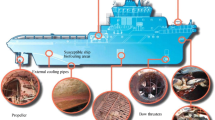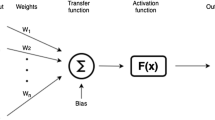Abstract
Models for underwater vehicle explaining its relationship between movement and the force exerting on the robot permit a wide range of development to be used in control and navigation. Yet currently no general method arrives a better model with structure and parameters for vehicles automatically. Based on the empirical data, symbolic regression method inspired by natural selection is conducted to automatically detect realistic structure and parameters of vehicle model. The proposed method is completely general and does not assume any pre-existing models before identification, it can be applied “out of the box” to any given vehicle experiment data. To validate and compare our approach with parameter identification methods like Levenberg–Marquardt Algorithm and Genetic Algorithm, we systematically rediscover the laws underlying underwater vehicle models and neglected laws for reflect the environments. Predicted results for datasets show that we are able to find programs that are simple enough to lead to an actual accurate model for describing the mechanisms of the vehicle.






Similar content being viewed by others
References
Menezes T, Roth C (2014) Symbolic regression of generative network models. Sci Rep 4:6284
Huang G, Huang G-B, Song S, You K (2015) Trends in extreme learning machines: a review. Neural Netw 61:32–48
Schmidt M, Lipson H (2009) Distilling free-form natural laws from experimental data. Science 324(5923):81–85
Schwab I, Link N (2012) Learn more about your data: a symbolic regression knowledge representation framework. Int J Intell Sci 2(4A):135–142
Wang XG, Zou ZJ, Xu F, Ren RY (2014) Sensitivity analysis and parametric identification for ship manoeuvring in 4 degrees of freedom. J Mar Sci Technol 19(4):394–405
Sabet MT, Pouria S, Zarini M (2014) Extended and Unscented Kalman filters for parameter estimation of an autonomous underwater vehicle. Ocean Eng 91:329–339
Kim S, Billard A (2012) Estimating the non-linear dynamics of free-flying objects. Robot Auton Syst 60(9):1108–1122
Coelho LdS, Bora TC, Klein CE (2014) A genetic programming approach based on Lévy flight applied to nonlinear identification of a poppet valve. Appl Math Model 38(5–6):1729–1736
Coelho LdS, Pessôa MW (2009) Nonlinear model identification of an experimental ball-and-tube system using a genetic programming approach. Mech Syst Signal Process 23(5):1434–1446
Prestero T (2001) Verification of a six-degree of freedom simulation model for the REMUS autonomous underwater vehicle (MS thesis in Ocean Engineering). Massachusetts Institute of Technology, Cambridge
Baruch IS, Mariaca-Gaspar CR (2009) A levenberg-marquardt learning applied for recurrent neural identification and control of a wastewater treatment bioprocess. Int J Intell Syst 24(11):1094–1114
Zhou SX, Cao JY, Chen YQ (2013) Genetic algorithm-based identification of fractional-order systems. Entropy 15(5):1624–1642
Chang W-D (2007) Nonlinear system identification and control using a real-coded genetic algorithm. Appl Math Model 31(3):541–550
Fossen TI (1994) Guidance and control of ocean vehicles. Wiley, New York
García-Valdovinos LG, Salgado-Jiménez T, Bandala-Sánchez M, Nava-Balanzar L, Hernández-Alvarado R, Cruz-Ledesma JA (2014) Modelling, design and robust control of a remotely operated underwater vehicle. Int J Adv Robot Syst 11(2):119–132
Tang S, Ura T, Nakatani T, Thornton B, Jiang T (2009) Estimation of the hydrodynamic coefficients of the complex-shaped autonomous underwater vehicle TUNA-SAND. J Mar Sci Technol 14(3):373–386
Yang R, Clement B, Mansour A, Li HJ, Li M, Wu NL (2014) Modeling of a complex-shaped underwater vehicle. In: 2014 IEEE international conference on autonomous robot systems and competitions (ICARSC2014). Espinho, Portugal
Gandomi AH, Alavi AH (2011) A new multi-gene genetic programming approach to nonlinear system modeling. Part I: materials and structural engineering problems. Neural Comput Appl 21(1):171–187
Feng X-T, Chen B-R, Yang C, Zhou H, Ding X (2006) Identification of visco-elastic models for rocks using genetic programming coupled with the modified particle swarm optimization algorithm. Int J Rock Mech Min Sci 43(5):789–801
Garg A, Tai K, Vijayaraghavan V, Singru PM (2014) Mathematical modelling of burr height of the drilling process using a statistical-based multi-gene genetic programming approach. Int J Adv Manuf Technol 73(1–4):113–126
Gandomi AH, Alavi AH (2011) A new multi-gene genetic programming approach to non-linear system modeling. Part II: geotechnical and earthquake engineering problems. Neural Comput Appl 21(1):189–201
Stoutemyer DR (2013) Can the Eureqa symbolic regression program, computer algebra, and numerical analysis help each other? Not Am Math Soc 60(06):713
Schmidt M, Lipson H (2010) Symbolic regression of implicit equations. Genet Program Theory Pract Vii:73–85
Acknowledgments
This work is supported by the National High Technology Research and Development Program of China (863 Program, Grant No. 2012AA092103). The authors also would like to express their appreciation to Y. Liu from Ship Maneuvering and Control Laboratory in Shanghai Jiao Tong University for their support to complete this work successfully.
Author information
Authors and Affiliations
Corresponding author
About this article
Cite this article
Wu, NL., Wang, XY., Ge, T. et al. Parametric identification and structure searching for underwater vehicle model using symbolic regression. J Mar Sci Technol 22, 51–60 (2017). https://doi.org/10.1007/s00773-016-0396-8
Received:
Accepted:
Published:
Issue Date:
DOI: https://doi.org/10.1007/s00773-016-0396-8




